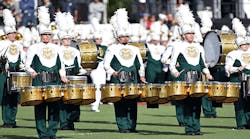Professional musicians such as orchestra, band members and music teachers, as well as others in the music industry such as disc jockeys, audio engineers and crew members all are at risk for developing permanent hearing loss, ringing in the ears and other hearing disorders from prolonged exposure to loud music.
Exposures to noise exceeding 85 decibels over 8 hours (dBA) are considered hazardous, and if the noise reaches 100 dBA, it only could take 15 minutes to cause permanent damage if exposed for a prolonged period of time.
“Research has shown that sound levels on stage at rock concerts or during orchestral performances often exceed NIOSH’s recommended exposure limit of 85 dBA,” said Chuck Kardous, MS, PE, a NIOSH research engineer. “It’s important for musicians to be aware of the risk for permanent hearing damage and take steps, such as those outlined in this recent Workplace Solutions document, to protect themselves.”
To mitigate potential hearing damage for professional musicians, NIOSH recommends that employers, music venue operators, schools and colleges, consider the following:
- Implement a hearing conservation program that includes annual testing and training in workplaces that have noise levels that exceed 85 dBA.
- Encourage participation in educational and awareness campaigns on music-induced hearing loss.
- Increase distances between individuals and instruments when feasible.
- Conduct regular sound level assessments.
- Identify hearing protection solutions that work best for the individual musicians or affected workers.
The agency suggests that musicians consider the following:
- Play music at lower levels during individual and group rehearsals, whenever possible.
- Wear hearing protection when appropriate.
- Have annual hearing evaluations performed by an experienced audiologist.
- Give their ears some rest by taking advantage of breaks in quiet areas when possible.
For the complete list of recommendations, download “Workplace Solutions: Reducing the Risk of Hearing Disorders among Musicians.”
NIOSH’s new recommendations are based on a series of studies and collaborations with musicians and music schools. In 2012, NIOSH conducted a Health Hazard Evaluation where NIOSH researchers measured sound levels during middle and high school music classes and marching band rehearsals. Findings showed that sound levels during most band rehearsals exceeded 91 dBA and reached more than 100 dBA at times, exposing the band director to sound levels capable of causing permanent hearing damage.
For more information about occupational hearing loss, visit www.cdc.gov/niosh/topics/noise/. NIOSH is the federal agency that conducts research and makes recommendations for preventing work-related injuries, illnesses and deaths.

